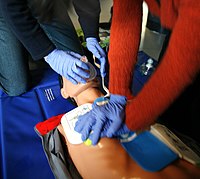
Photo from wikipedia
BACKGROUND Automated external defibrillators (AEDs) can be used by bystanders to provide rapid defibrillation for patients with out-of-hospital cardiac arrest (OHCA). Whether neighborhood characteristics are associated with AED use is… Click to show full abstract
BACKGROUND Automated external defibrillators (AEDs) can be used by bystanders to provide rapid defibrillation for patients with out-of-hospital cardiac arrest (OHCA). Whether neighborhood characteristics are associated with AED use is unknown. Furthermore, the association between AED use and outcomes has not been well characterized for all (i.e. shockable and non-shockable) public OHCAs. METHODS We included public, non-911-responder witnessed OHCAs registered in the Cardiac Arrest Registry to Enhance Survival (CARES) between 2013 and 2016. The primary patient outcome was survival to hospital discharge with a favorable functional outcome. We first assessed the association between neighborhood characteristics and bystander AED use using logistic regression and then assessed the association between bystander AED use and patient outcomes in a propensity score matched cohort. RESULTS 25,182 OHCAs were included. Several neighborhood characteristics, including the proportion of people living alone, the proportion of white people, and the proportion with a high-school degree or higher, were associated with bystander AED use. 5132 OHCAs were included in the propensity score-matched cohort. Bystander AED use was associated with an increased risk of a favorable functional outcome (35% vs. 25%, risk difference: 9.7% [95% confidence interval: 7.2%, 12.2%], risk ratio: 1.38 [95% confidence interval: 1.27, 1.50]). This was driven by increased favorable functional outcomes with AED use in patients with shockable rhythms (58% vs. 39%) but not in patients with non-shockable rhythms (10% vs. 10%). CONCLUSIONS Specific neighborhood characteristics were associated with bystander AED use in OHCA. Bystander AED use was associated with an increase in favorable functional outcome.
Journal Title: Resuscitation
Year Published: 2018
Link to full text (if available)
Share on Social Media: Sign Up to like & get
recommendations!